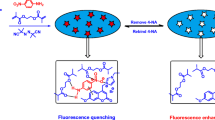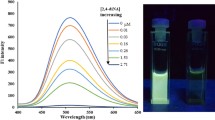Abstract
A highly effective fluorescent molecularly imprinted sensor (F-PDA-MIS) based on fluorescent polydopamine (F-PDA) was successfully synthesized for selective and ultrafast detection of p-nitrophenol (P-NP) in drinking water. F-PDA with abundant surface functional groups has been artfully modified to firstly serve as both fluorescent monomer and functional monomer in the synthesis of a uniform luminous F-PDA-MIS, which can greatly improve the detection efficiency. As expected, F-PDA-MIS had an obvious emission wavelength of 535 nm with the optimal excitation wavelength at 400 nm. Specially, F-PDA-MIS could detect P-NP in the range 100 to 1100 nM with much lower detection limit of 24.2 nM within 120 s compared with other conventional imprinted fluorescent sensors based on pure quantum dots (QDs) or dyes. This excellent test phenomenon is mainly ascribed to the rapid electron transfer between F-PDA and P-NP. Satisfactory recovery of 98.0–104% for mineral water and 98.6–106% for boiling water were obtained with relative standard deviations (RSDs) of 2.7–3.4% and 2.6–3.5% respectively. The detection reliability of F-PDA-MIS was verified by the comparison with high-performance liquid chromatography (HPLC–UV). Consequently, F-PDA as a fluorescence functional monomer has been shown to be a possible strategy to effectively improve the detection limit and shorten response time of the target determination in water..
Graphical abstract









Similar content being viewed by others
References
Han L, Liu SG, Liang JY, Ju YJ, Li NB, Luo HQ (2019) pH-mediated reversible fluorescence nanoswitch based on inner filter effect induced fluorescence quenching for selective and visual detection of 4-nitrophenol. J Hazard Mater 362:45–52. https://doi.org/10.1016/j.jhazmat.2018.09.025
Hu YP, Gao ZJ (2020) Sewage sludge in microwave oven: a sustainable synthetic approach toward carbon dots for fluorescent sensing of para-Nitrophenol. J Hazard Mater 382:121048. https://doi.org/10.1016/j.jhazmat.2019.121048 ((1-7))
Qiu N, Liu Y, Xiang M, Lu XM, Yang Q, Guo R (2018) A facile and stable colorimetric sensor based on three-dimensional graphene/mesoporous Fe3O4 nanohybrid for highly sensitive and selective detection of p-nitrophenol. Sensors Actuators B Chem 266:86–94. https://doi.org/10.1016/j.snb.2018.03.059
Bo LL, Quan X, Chen S, Zhao HM, Zhao YZ (2006) Degradation of p-nitrophenol in aqueous solution by microwave assisted oxidation process through a granular activated carbon fixed bed. Water Res 40:3061–3068. https://doi.org/10.1016/j.watres.2006.06.030
Zhai HY, Xiao WL, Li Y, Li RZ, Liu HJ, Yu LP (2020) Sensitive and selective determination of 4-nitrophenol in water and food using modified polyethyleneimine-capped carbon dots. J Chin Chem Soc 67:1230–1238. https://doi.org/10.1002/jccs.201900494
Wei Y, Kong LT, Yang R, Wang L, Liu JH, Huang XJ (2011) Single-walled carbon nanotube/pyrenecyclodextrin nanohybrids for ultrahighly sensitive and selective detection of p-nitrophenol. Langmuir 27:10295–10301. https://doi.org/10.1021/la201691c
Le XD, Dong ZP, Liu YS, Jin ZC, Huy TD, Le M, Ma JT (2014) Palladium nanoparticles immobilized on core-shell magnetic fibers as a highly efficient and recyclable heterogeneous catalyst for the reduction of 4-nitrophenol and Suzuki coupling reactions. J Mater Chem A 2:19696–19706. https://doi.org/10.1039/C4TA04919E
Wang ML, Jiang TT, Lu Y, Liu HJ, Chen Y (2013) Gold nanoparticles immobilized in hyperbranched polyethylenimine modified polyacrylonitrile fiber as highly efficient and recyclable heterogeneous catalysts for the reduction of 4-nitrophenol. J Mater Chem A 1:5923–5933. https://doi.org/10.1039/C3TA10293A
Uzer A, Ercag E, Apak R (2004) Selective spectrophotometric determination of trinitrotoluene, trinitrophenol, dinitrophenol and mononitrophenol. Anal Chim Acta 505:83–93. https://doi.org/10.1016/S0003-2670(03)00674-3
Colades JI, de Luna MDG, Secondes MFN, Huang CP (2019) Electrochemical in-situ hydrogen peroxide generation in a packed-bed reactor for Fenton oxidation of p-nitrophenol in aqueous solution. Process Saf Environ Prot 123:161–168. https://doi.org/10.1016/j.psep.2018.10.014
Zhang JJ, Cui SQ, Ding YP, Yang XX, Guo K, Zhao JT (2018) Two-dimensional mesoporous ZnCo2O4 nanosheets as a novel electrocatalyst for detection of o-nitrophenol and p-nitrophenol. Biosens Bioelectron 112:177–185. https://doi.org/10.1016/j.bios.2018.03.021
Yamauchi Y, Ido M, Ohta M, Maeda H (2004) High performance liquid chromatography with an electrochemical detector in the cathodic mode as a tool for the determination of p-nitrophenol and assay of acid phosphatase in urine samples. Chem Pharm Bull 52:552–555. https://doi.org/10.1248/cpb.52.552
Skog KM, Xiong FLZ, Kawashima H, Doyle E, Soto R, Gentner DR (2019) Compact, automated, inexpensive, and field-deployable vacuum-outlet gas chromatograph for trace-concentration gas-phase organic compounds. Anal Chem 91:1318–1327. https://doi.org/10.1021/acs.analchem.8b03095
Shirani MP, Rezaei B, Ensafi AA, Ramezani M (2021) Development of an eco-friendly fluorescence nanosensor based on molecularly imprinted polymer on silica-carbon quantum dot for the rapid indoxacarb detection. Food Chem 339:127920. https://doi.org/10.1016/j.foodchem.2020.127920 ((1-7))
Huang SY, Guo ML, Tan JA, Geng YY, Wu JY, Tang YW, Su CC, Lin CC, Liang Y (2018) Novel fluorescence sensor based on all-inorganic perovskite quantum dots coated with molecularly imprinted polymers for highly selective and sensitive detection of omethoate. ACS Appl Mater Interfaces 10:39056–39063. https://doi.org/10.1021/acsami.8b14472
Wang T, Wei X, Zong Y, Zhang S, Guan W (2020) An efficient and stable fluorescent sensor based on APTES-functionalized CsPbBr3 perovskite quantum dots for ultrasensitive tetracycline detection in ethanol. J Mater Chem C 8:12196–12203. https://doi.org/10.1039/D0TC02852E
Yang Q, Li JH, Wang XY, Xiong H, Chen LX (2019) Ternary emission of a blue-, green-, and red-based molecular imprinting fluorescence sensor for the multiplexed and visual detection of bovine hemoglobin. Anal Chem 91:6561–6568. https://doi.org/10.1021/acs.analchem.9b00082
Wang JX, Cheng RJ, Wang YY, Sun L, Chen L, Dai XH, Pan JM, Pan GQ, Yan YS (2018) Surface-imprinted fluorescence microspheres as ultrasensitive sensor for rapid and effective detection of tetracycline in real biological samples. Sensors Actuators B Chem 263:533–542. https://doi.org/10.1016/j.snb.2018.02.150
Wang Z, Xu C, Lu YX, Wei GY, Ye G, Sun TX, Chen J (2018) Microplasma electrochemistry controlled rapid preparation of fluorescent polydopamine nanoparticles and their application in uranium detection. Chem Eng J 344:480–486. https://doi.org/10.1016/j.cej.2018.03.096
Chen MH, Wen Q, Gu FL, Gao JW, Zhang CC, Wang QM (2018) Mussel chemistry assembly of a novel biosensing nanoplatform based on polydopamine fluorescent dot and its photophysical features. Chem Eng J 342:331–338. https://doi.org/10.1016/j.cej.2018.02.099
Nam H, Kim B, Ko M, Jin M, Kim JM, Jung DY (2012) A new mussel-inspired polydopamine sensitizer for dye-sensitized solar cells: controlled synthesis and charge transfer. Chem Eur J 18:14000–14007. https://doi.org/10.1002/chem.201202283
Cao Y, Zhang X, Tao L, Li K, Xue Z, Feng L, Wei Y (2013) Mussel-inspired chemistry and Michael addition reaction for efficient oil/water separation. ACS Appl Mater Interfaces 5:4438–4442. https://doi.org/10.1021/am4008598
Cheng C, Nie S, Li S, Peng H, Yang H, Ma L, Sun S, Zhao C (2013) Biopolymer functionalized reduced graphene oxide with enhanced biocompatibility via mussel inspired coatings/anchors. J Mater Chem B 1:265–275. https://doi.org/10.1039/C2TB00025C
Lee Y, Lee H, Kim YB, Kim J, Hyeon T, Park H, Messersmith PB, Park TG (2008) Bioinspired surface immobilization of hyaluronic acid on monodisperse magnetite nanocrystals for targeted cancer imaging. Adv Mater 20:4154–4157. https://doi.org/10.1002/adma.200800756
Ma Y-R, Niu H-Y, Zhang X-L, Cai Y-Q (2011) Colorimetric detection of copper ions in tap water during the synthesis of silver/dopamine nanoparticles. Chem Commun 47:12643–12645. https://doi.org/10.1039/C1CC15048K
Zhang L, Wu J, Wang Y, Long Y, Zhao N, Xu J (2012) Combination of bioinspiration: a general route to superhydrophobic particles. J Am Chem Soc 134:9879–9881. https://doi.org/10.1021/ja303037j
Zhang X, Wang S, Xu L, Feng L, Ji Y, Tao L, Li S, Wei Y (2012) Biocompatible polydopamine fluorescent organic nanoparticles: facile preparation and cell imaging. Nanoscale 4:5581–5584. https://doi.org/10.1039/C2NR31281F
Liu XS, Cao JM, Li H, Li JY, Jin Q, Ren KF, Ji J (2013) Mussel-inspired polydopamine: a biocompatible and ultrastable coating for nanoparticles in vivo. ACS Nano 7:9384–9395. https://doi.org/10.1021/nn404117j
Chien HW, Kuo WH, Wang MJ, Tsai SW, Tsai WB (2012) Tunable micropatterned substrates based on poly(dopamine) deposition via microcontact printing. Langmuir 28:5775–5782. https://doi.org/10.1021/la300147p
Fu YC, Li PH, Xie QJ, Xu XH, Lei LH, Chen C, Zou C, Deng WF, Yao SZ (2009) One-pot preparation of polymer-enzyme-metallic nanoparticle composite films for high-performance biosensing of glucose and galactose. Adv Func Mater 19:1784–1791. https://doi.org/10.1002/adfm.200801576
Wan Q, Wang K, Du HL, Huang HY, Liu MY, Deng FJ, Dai YF, Zhang XY, Wei Y (2015) A rather facile strategy for the fabrication of PEGylated AIE nanoprobes. Polym Chem 6:5288–5294. https://doi.org/10.1039/C5PY00735F
Ma L, Qin H, Cheng C, Xia Y, He C, Nie CX, Wang LR, Zhao CS (2014) Mussel-inspired self-coating at macro-interface with improved biocompatibility and bioactivity via dopamine grafted heparin-like polymers and heparin. J Mater Chem B 2:363–375. https://doi.org/10.1039/C3TB21388A
Cheng C, Sun SD, Zhao CS (2014) Progress in heparin and heparin-like/mimicking polymer-functionalized biomedical membranes. J Mater Chem B 2:7649–7672. https://doi.org/10.1039/C4TB01390E
Liu MY, Ji JZ, Zhang XY, Zhang XQ, Yang B, Deng FJ, Li Z, Wang K, Yang Y, Wei Y (2015) Self-polymerization of dopamine and polyethyleneimine: novel fluorescent organic nanoprobes for biological imaging applications. J Mater Chem B 3:3476–3482. https://doi.org/10.1039/C4TB02067G
Wang R, Yu B, Jiang XS, Yin J (2012) Understanding the host-guest interaction between responsive core-crosslinked hybrid nanoparticles of hyperbranched poly(ether amine) and dyes: the selective adsorption and smart separation of dyes in water. Adv Func Mater 22:2606–2616. https://doi.org/10.1002/adfm.201102902
Liu XQ, Zhou ZP, Wang T, Deng PY, Yan YS (2020) Visual monitoring of trace water in organic solvents based on ecofriendly b/r-CDs ratiometric fluorescence test paper. Talanta 216:120958. https://doi.org/10.1016/j.talanta.2020.120958 ((1-7))
Xiao N, Liu SG, Mo S, Li N, Ju YJ, Ling Y, Li NB, Luo HQ (2018) Highly selective detection of p-nitrophenol using fluorescence assay based on boron, nitrogen co-doped carbon dots. Talanta 184:184–192. https://doi.org/10.1016/j.talanta.2018.02.114
Sun J, Zhao JH, Wang L, Li HW, Yang F, Yang XR (2018) Inner filter effect-based sensor for horseradish peroxidase and its application to fluorescence immunoassay. Acs Sens 3:183–190. https://doi.org/10.1021/acssensors.7b00830
Ma YS, Cen Y, Sohail M, Xu GH, Wei FD, Shi ML, Xu XM, Song YY, Ma YJ, Hu Q (2017) A ratiometric fluorescence universal platform based on N, Cu Codoped carbon dots to detect metabolites participating in H2O2-generation reactions. ACS Appl Mater Interfaces 9:33011–33019. https://doi.org/10.1021/acsami.7b10548
Foroughirad S, Haddadi-Asl V, Khosravi A, Salami-Kalajahi M (2021) Magnetic halloysite-based molecularly imprinted polymer for specific recognition of sunset yellow in dyes mixture. Polym Adv Technol 32:803–814. https://doi.org/10.1002/pat.5132
Funding
This work was supported by the National Natural Science Foundation of China (Nos. 21808089, 51803080), China Postdoctoral Science Foundation (No. 2019M661750, 2019T120400), Natural Science Foundation of Jiangsu Province (No. BK20190245), Major projects of education department of Jiangsu province (No. 17KJA530003), and Programs of Senior Talent Foundation of Jiangsu University (No. 15JDG024).
Author information
Authors and Affiliations
Corresponding authors
Ethics declarations
Conflict of interest
The authors declare no conflict of interest.
Additional information
Publisher's note
Springer Nature remains neutral with regard to jurisdictional claims in published maps and institutional affiliations.
Supplementary Information
Below is the link to the electronic supplementary material.
604_2021_5106_MOESM1_ESM.docx
Supplementary file1 The experiments of synthesis optimization of F-PDA, performance analysis of FPDAand demonstration experiment of F-PDA to replace conventional functionalmonomer. Images of synthesis optimization of F-PDA, fluorescence independence ofF-PDA, performance analysis of F-PDA, fluorescence intensities of F-PDA in a month,Thermogravimetric analysis of F-PDA-MIS and F-PDA-NIS, fluorescence quenchingmechanism analysis, proof experiment of F-PDA as a fluorescence functional monomerand comparison of reaction time to other fluorescent probes, the HPLC-UV detectionresults of P-NP concentration in mineral water and boiling water and comparison ofMISs in the terms of response time and detection limit. (DOCX 1473 KB)
Rights and permissions
About this article
Cite this article
Xu, Y., Huang, T., Meng, M. et al. Fluorescent polydopamine based molecularly imprinted sensor for ultrafast and selective detection of p-nitrophenol in drinking water. Microchim Acta 189, 25 (2022). https://doi.org/10.1007/s00604-021-05106-3
Received:
Accepted:
Published:
DOI: https://doi.org/10.1007/s00604-021-05106-3




